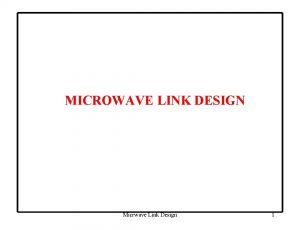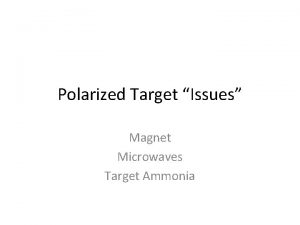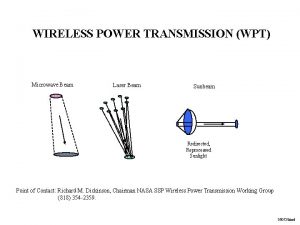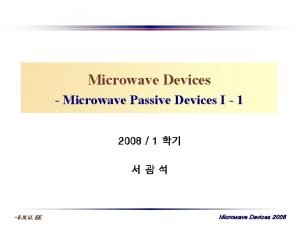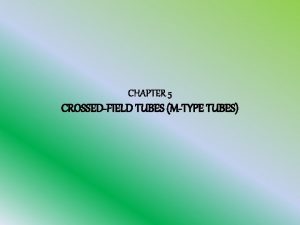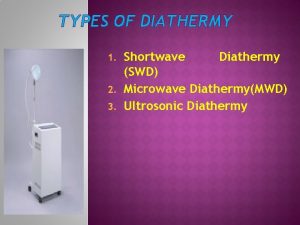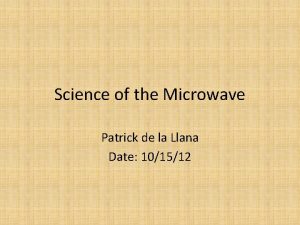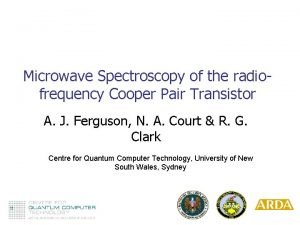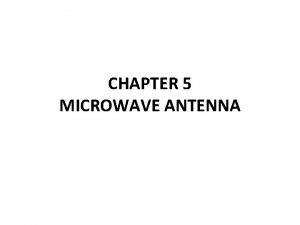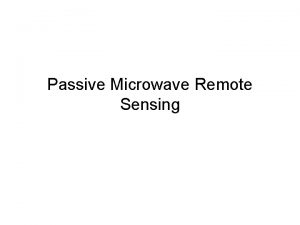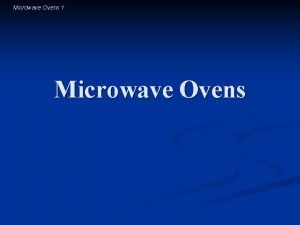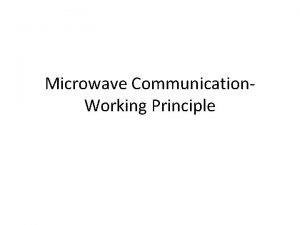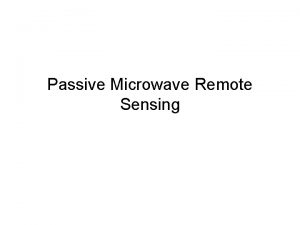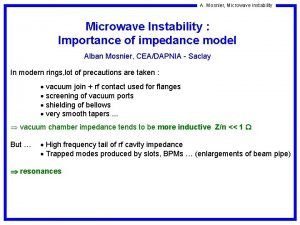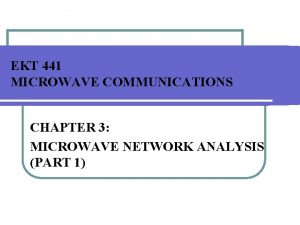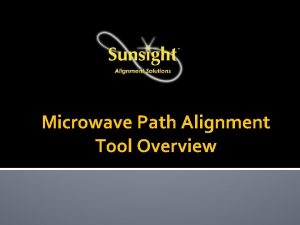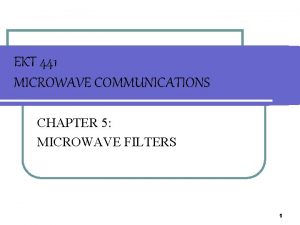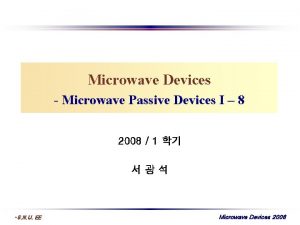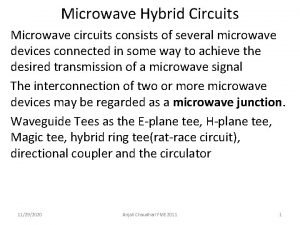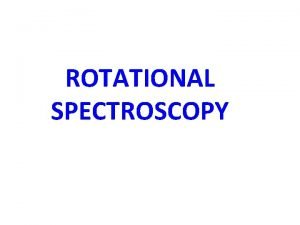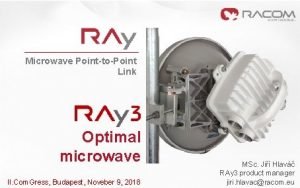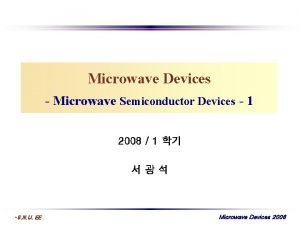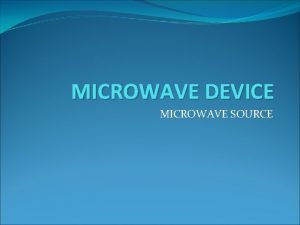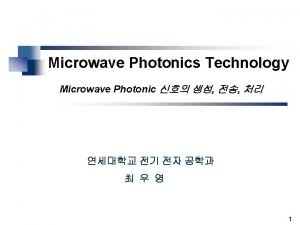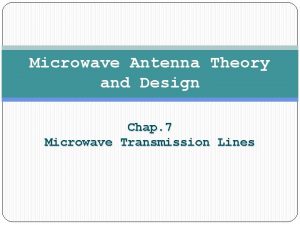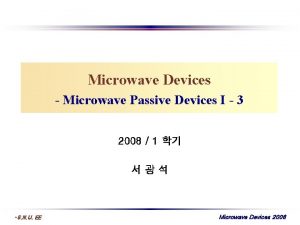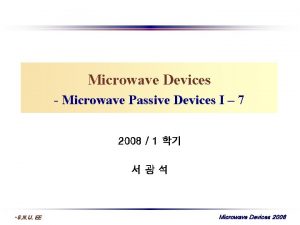EMCommunications Applications Aly E Fathy Outline The microwave




























































- Slides: 60

E&M/Communications Applications Aly E Fathy

Outline • • • The microwave band Non-communication applications Communication Applications Breakthroughs Various Areas of Research at UT and other Research Centers • Courses

Microwaves Frequency Wavelength l Long waves 30 -300 k. Hz 10 -1 km Medium waves (MW) 300 -3000 k. Hz 1000 -100 m Short waves (SW) 3 -30 MHz 100 -10 m Very high frequency (VHF) waves 30 -300 MHz 0. 3 -30 GHz* 10 -1 m 100 -1 cm 30 -300 GHz 10 -1 mm 300 -3000 GHz 1 -0. 1 mm Microwaves Millimeter waves Submillimeter waves Infrared (including far-infrared) 300 -416, 000 GHz * 1 GHz = 1 gigahertz = 10 Hertz or cycles per second, + 1 mm = 10 -6 m. 104 -0. 72 mm

Non-Communication Application Industrial Microwave Furnace Modular Unit Waveguide Inert Environment Crucible Insulation Mold Core Mold

Free Space Communication Attenuation of the Atmosphere at Various Wavelengths 60 40 20

Why Microwaves Radio equipments are classified under VHF, UHF & Microwaves. VHF and UHF radios used when few circuits are needed and narrow bandwidth. Earlier equipments were large in size and use Analog Technology. Recently Digital Radio with better efficiency is being used.

A Century of Antennas-- from Hertz to Hand-Held

Very large array of 27 steerable parabolic dish Antennas 25 meter diameter, operating at ~ cm wavelength To listen to signals transmitted billions of year away 24 GPS Antennas, medium earth orbits-MEO Operating at 20 cm wavelength Uses helix antennas, at 20, 000 km Hand-held cell-phones Operating at 30 cm wavelength

Microwave Use • Lower bands are already occupied • Now we have better electronics, and modulation schemes Advantages of Microwave Utilization: • Antennas are more directive—better beam control. • Wider operating bandwidth. • Smaller size elements

Microwave Systems Microwave communication is line of sight radio communication For directive antennas, or broadcasting with omi-directional antennas Radio Transmission: the speech signals are converted to EM Power is transmitted in space towards destination EM waves are intercepted by receiving antennas and signal power is collected

Types of Antennas used can be: • Omni-directional-in this case radio power is transmitted Uniformly in all directions Such type of antenna are preferred where uniform coverage is desired such as in cellular systems. • Directional: in case of UHF communication. • Highly directional: in case of microwave communications, microwave signals are transmitted in very narrow beam. Normally 3 M Diameter Antenna at 2 GHz BW has half power of about 3. 4 degrees beam width.

Coverage

Applications: Radio Communications Radio Communication is in use since early 30’s. First was used for broadcasting then commercial communication. Radio used for long distance telephone service. Many phone lines are connected to an Exchange, and many exchanges to a tower

Cellular Communication For providing cellular communication a number of antennas at a particular height are installed around a circular platform

DBS Antennas

DBS-History

Current Solutions for US DBS Broadside Patch Array Antennas Complete Mechanical Steering High Fabrication Cost. >12 inch Phased Array Antennas ~6 inch COST Proposed Solution Reflector Antennas for Stationary Reception Complete Mechanical Steering with limited range (due to beam tilt) SIW, Low Fabrication Cost Low Profile Reflector Antennas Complete Mechanical Steering Low Fabrication Cost. ~12 inch Mobility

Research Progress 12*64 Elements Slotted SIW Full Array 12 x 16 Elements SIW Sub-Array Directivity 13 x 48 Elements Full Array 13 x 32 Elements SIW Array With Folded Feed Network 13 x 6 elements Sub-Array 12 Elements Slotted SIW Array Efficiency 13 Elements Slotted Waveguide

Antennas for Mobile Systems

Why Do we need Reconfigurable Antennas? • Limited Space, and Volume • Trend to further miniaturization Difficulty to attain Directivity G=4 p. A/l 2, G = -18. 5 d. B/cm 2 @1 GHz Very Compact (you add 3 d. B when you double the Area) (you add 6 d. B when you double the Frequency) • Strong Antenna Interference due to Proximity • More Services means more antennas • Many are not used in same time. Tiny Multifunction Does it all

Antenna Alternatives for Multi-Radio Application Radio 1 Radio 2 Multiple Radios Ant. Gain Broad Band Antenna Radio 3 Frequency • Covers all bands of interest, Good for sim-ops Radio n Ant. Gain Reconfigurable Antenna Frequency • Very good noise immunity, high Flexibility • Requires switches, Poor for true sim-ops Ant. Gain • Higher Noise , Non Uniformity in Ant. Gain Multi-Band Antenna Frequency • Covers few bands of interest, OOB noise supp. • Poor iso. between radios, stringent filter spec.

Mini-Nested Patches

Reconfigurable Multiband 2 nd Band 1 st Band 802. 11 b/g /n 2 nd Band DCS/PCS/IMT 2000 1 st Band GSM 850/900 802. 11 a

Research Progress 42 mm 11 m m Switch Locations 50 cm coaxial cable RF blocking resistor DC Feeds “Maze” Reconfigurable Fractal Loop Antenna MEMS Reconfigurable Multi-band branched Monopole Antenna Switches “mini-Maze” Reconfigurable Bent Monopole Antenna with MEMS switch Reconfigurable Multi-band Twin PIFA Antenna with PIN diode switch 90 mm 10 mm p-i-n diodes 50 cm coaxial cable Ground

Power Amplifiers and Combiners

THz- BACKGROUND • The detection of concealed weapons and explosives represents one of the most daunting problems facing the military and civilian law enforcement personnel. • The exposure and identification of biological and chemical weapons is also a major homeland security concern. • Terahertz (THz) imaging, by virtue of its ability to penetrate materials and its short wavelength (leading to high resolution), and THz spectroscopy, due to its capability to recognize unique signatures of dangerous biological and chemical agents, provide the most promising approach to address these problems.

Homeland Security Applications Potential Security Applications Ø Detection of hidden weapons and explosives Ø Detecting non-metallic weapons Ø Postal screening of envelopes for bacteria Ø Chem/bio detection Envelope Postal screening Explosives Stand-off detection Security screening wand

Terahertz Images Can Reveal Objects Concealed Under Cloth, Paper, Tape, Even Behind Walls Objects Concealed Under clothes Knife Wrapped in Newspaper

See Through Prototype System Universal Automation Mechanism: Developed in Matlab Utilized GPIB bus and parallel port protocol 29

Powerful Medical Imaging Capabilities of THz Diseased skin Normal skin White light image Skin Cancer THz image Brain Dental THz device and probe (Tera. View)

CONFORMAL ANTENNAS …Fast Computations, New Materials… • New Exotic Materials have been recently developed. • Stealth Technology and Many others can benefit

E-Textiles

Courses Offered at UT Fields Antennas and Propagation Microwave circuits EMC Electromagnetic Fields II Phased Array Antennas II Wireless Communications

Holographic Antenna Features • True re-configurable aperture, NOT simple switching. • The surface wave provides relatively low loss RF distribution channels • Phased array performance without phased array feed complexity or cost • Highly compact package

Conductive Fringe Pattern Conductive Region (Yellow) Non-Conductive Region (Blue) Far-Field Pattern Radar Scanned Aim Point Radar Azimuth (deg): Radar Elevation (deg): 015 000

Description of Scenario: • Search Along Azimuth 0 -30 Deg, 0 Deg Elevation • Array Turned ‘Off’ - Non-Conducting Surface • Search Along Azimuth 30 Deg to 0 Deg, 5 Deg Elevation • Place Target Into Track, Then Lose Track • Switch to Wide Beam to Re-Acquire Target • Continue Target Track

Mode: Search Radar Azimuth (deg): Radar Elevation (deg): 000

Mode: Search Radar Azimuth (deg): Radar Elevation (deg): 005 000

Mode: Search Radar Azimuth (deg): Radar Elevation (deg): 010 000

Mode: Search Radar Azimuth (deg): Radar Elevation (deg): 015 000

Mode: Search Radar Azimuth (deg): Radar Elevation (deg): 020 000

Mode: Search Radar Azimuth (deg): Radar Elevation (deg): 025 000

Mode: Search Radar Azimuth (deg): Radar Elevation (deg): 030 000

Mode: OFF Radar Azimuth (deg): Radar Elevation (deg): 000

Mode: OFF Radar Azimuth (deg): Radar Elevation (deg): 000

Mode: Search Radar Azimuth (deg): Radar Elevation (deg): 030 005

Mode: Search Radar Azimuth (deg): Radar Elevation (deg): 025 005

Mode: Search Radar Azimuth (deg): Radar Elevation (deg): 020 005

Mode: Search Radar Azimuth (deg): Radar Elevation (deg): 015 005

Mode: Search Radar Azimuth (deg): Radar Elevation (deg): 010 005

Mode: Track Radar Azimuth (deg): Radar Elevation (deg): 012 006

Mode: Track Radar Azimuth (deg): Radar Elevation (deg): 016 010

Mode: Track Radar Azimuth (deg): Radar Elevation (deg): 020 014

Mode: Re-Acquire Radar Azimuth (deg): Radar Elevation (deg): 020 014

Mode: Re-Acquire Radar Azimuth (deg): Radar Elevation (deg): 020 018

Mode: Re-Acquire Radar Azimuth (deg): Radar Elevation (deg): 016 018

Mode: Re-Acquire Radar Azimuth (deg): Radar Elevation (deg): 016 014

Mode: Track Radar Azimuth (deg): Radar Elevation (deg): 018 016

Mode: Track Radar Azimuth (deg): Radar Elevation (deg): 021 018

Mode: Track Radar Azimuth (deg): Radar Elevation (deg): 024 020
 Riham mohamed aly
Riham mohamed aly Ponpes qoryatul qur'an putra
Ponpes qoryatul qur'an putra Microwave applications
Microwave applications How to write a quote sandwich
How to write a quote sandwich Trời xanh đây là của chúng ta thể thơ
Trời xanh đây là của chúng ta thể thơ Hệ hô hấp
Hệ hô hấp Số nguyên là gì
Số nguyên là gì Công thức tính độ biến thiên đông lượng
Công thức tính độ biến thiên đông lượng Tỉ lệ cơ thể trẻ em
Tỉ lệ cơ thể trẻ em đặc điểm cơ thể của người tối cổ
đặc điểm cơ thể của người tối cổ Các châu lục và đại dương trên thế giới
Các châu lục và đại dương trên thế giới ưu thế lai là gì
ưu thế lai là gì Các môn thể thao bắt đầu bằng tiếng đua
Các môn thể thao bắt đầu bằng tiếng đua Tư thế ngồi viết
Tư thế ngồi viết Cái miệng xinh xinh thế chỉ nói điều hay thôi
Cái miệng xinh xinh thế chỉ nói điều hay thôi Hát kết hợp bộ gõ cơ thể
Hát kết hợp bộ gõ cơ thể Cách giải mật thư tọa độ
Cách giải mật thư tọa độ Từ ngữ thể hiện lòng nhân hậu
Từ ngữ thể hiện lòng nhân hậu Tư thế ngồi viết
Tư thế ngồi viết Chó sói
Chó sói Thẻ vin
Thẻ vin V. c c
V. c c Thơ thất ngôn tứ tuyệt đường luật
Thơ thất ngôn tứ tuyệt đường luật Khi nào hổ mẹ dạy hổ con săn mồi
Khi nào hổ mẹ dạy hổ con săn mồi Thế nào là hệ số cao nhất
Thế nào là hệ số cao nhất Diễn thế sinh thái là
Diễn thế sinh thái là Vẽ hình chiếu vuông góc của vật thể sau
Vẽ hình chiếu vuông góc của vật thể sau Phép trừ bù
Phép trừ bù Lời thề hippocrates
Lời thề hippocrates Tư thế worm breton
Tư thế worm breton đại từ thay thế
đại từ thay thế Vẽ hình chiếu đứng bằng cạnh của vật thể
Vẽ hình chiếu đứng bằng cạnh của vật thể Quá trình desamine hóa có thể tạo ra
Quá trình desamine hóa có thể tạo ra Thế nào là mạng điện lắp đặt kiểu nổi
Thế nào là mạng điện lắp đặt kiểu nổi Khi nào hổ con có thể sống độc lập
Khi nào hổ con có thể sống độc lập Các châu lục và đại dương trên thế giới
Các châu lục và đại dương trên thế giới Dot
Dot Biện pháp chống mỏi cơ
Biện pháp chống mỏi cơ Bổ thể
Bổ thể Phản ứng thế ankan
Phản ứng thế ankan Thiếu nhi thế giới liên hoan
Thiếu nhi thế giới liên hoan Fecboak
Fecboak Hát lên người ơi
Hát lên người ơi điện thế nghỉ
điện thế nghỉ Một số thể thơ truyền thống
Một số thể thơ truyền thống Questron technologies corp
Questron technologies corp Fade margin formula microwave
Fade margin formula microwave Microwaves target
Microwaves target Microwave wpt
Microwave wpt Passive and active microwave devices
Passive and active microwave devices Difference between linear beam tube and cross field tube
Difference between linear beam tube and cross field tube Types of electrode in swd
Types of electrode in swd History of popcorn
History of popcorn Percy spencer the inventor of the microwave oven igcse
Percy spencer the inventor of the microwave oven igcse Introduction to microwave engineering ppt
Introduction to microwave engineering ppt Electric fan energy transformation
Electric fan energy transformation Microwave spectroscopy definition
Microwave spectroscopy definition Lens antenna definition
Lens antenna definition Spectrum of electromagnetic waves
Spectrum of electromagnetic waves Microwave simulation software
Microwave simulation software














































